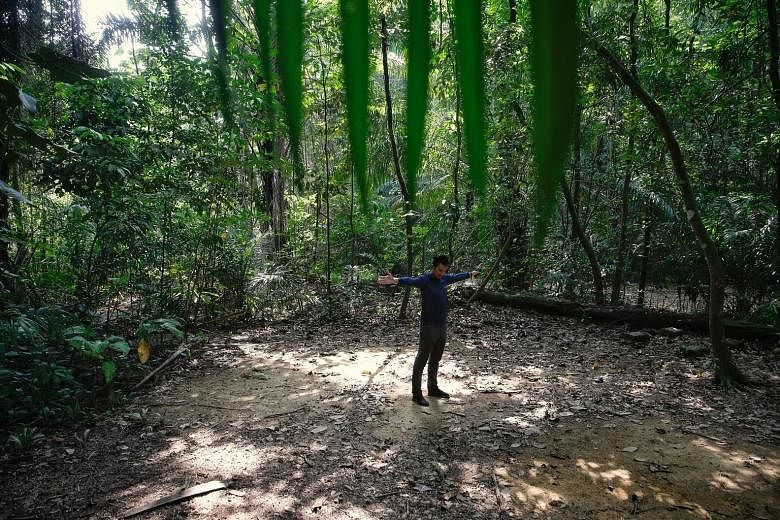Tunnelling under Singapore's largest nature reserve to build the Cross Island MRT Line would call for 3ha of forests next to the reserve to be cleared, which could mean loss of habitat for critically endangered wildlife.
But if mitigation measures are carried out - such as if trees are re-planted in the affected areas or security fences are made "wildlife-friendly" - the impact of the upcoming train line on the Central Catchment Nature Reserve could be reduced, the Land Transport Authority (LTA) said.
This was a key finding of a lengthy environmental impact assessment report for the Cross Island Line which the LTA released yesterday. The report had looked at how the construction and operation of the upcoming line could affect the reserve.
Even though the line may go 70m under the reserve - in a move by the authorities to further mitigate environmental impact - two structures at ground level are needed for ventilation. Initial plans had called for a tunnel at a depth of around 40m.
The ventilation structures fall outside reserve boundaries, but levelling the plots of land where the structures will stand would result in the loss of habitat for critically endangered wildlife such as the Raffles' banded langur and increase the likelihood of these animals being injured by traffic during construction, said the report.
Despite the "major" impact that the construction and operation of the Cross Island Line could have on biodiversity, this could be reduced to "moderate" or even "negligible" depending on the work site, provided that mitigation measures to reduce the impact are carried out, according to the report.
Almost 1,000 pages long, the report was done by consultancy Environmental Resources Management, an international firm with an office in Singapore, and detailed some strategies.
It suggested that to reduce the impact of construction works on wildlife, re-planting could reduce habitat loss, while installing rope bridges and poles could help canopy-dwelling species get from one forest patch to another.
Diverting discharge outlets away from rare freshwater streams could also help reduce pollution of the aquatic habitats.
In terms of reducing the impact of tunnel operations, the report said that other than wildlife-friendly fences, roosts and nests identified during inspections could be removed with the aid of the National Parks Board.
National University of Singapore biology lecturer N. Sivasothi said that even with the mitigation measures, it was a "big jump" to say that impact would be reduced from "major" to "moderate".
"The scale makes the impact sound benign. This is a big problem which the community and the Government need to review," he said.
The decision on whether to build under or around the reserve is still being mulled over, and an environmental impact assessment of the line for both alignments was done.
The latest study had found that for the skirting alignment, there would be "major" residual impact for residents due to "visual" elements - such as activities at above-ground work sites and the presence of workers. The alternative route would also involve above-ground works in wildlife-rich areas in the vicinity of Bukit Brown, said the report.
However, the report noted that the impact of these could be reduced to "moderate" with mitigation strategies similar to those for direct alignment.
Wildlife consultant Subaraj Rajathurai, whom LTA consulted for the project, noted that these areas on the skirting alignment were home to wildlife such as the Sunda pangolin and common palm civet.
However, these animals are more widespread compared with "forest specialists" - animals that live only in good forests, such as the Raffles' banded langur and the lesser mousedeer - that can be found in the forested plot east of the nature reserve, which would have to be cleared if the line is built there.
"The eastern node of the direct alignment is the area with threatened forest specialists, and im-pact there should be higher than moderate," said Mr Subaraj, who has been studying Singapore's forests for decades.
"The skirting node at Bukit Brown has animals such as the colugo and pangolin, but these animals, while threatened, are more widespread and should not be compared to the node in the direct alignment," he told The Straits Times.
LTA had earlier said that the alternative alignment could add about $2 billion to the rail project due to longer tunnels and extra ventilation facilities.
No figure was available for the total cost of adopting mitigation measures should the direct alignment be chosen.
-
GOING UNDER THE NATURE RESERVE
Pros:
•Lower construction cost
•Shortens travel time by six minutes
•No additional acquisition of property needed
•Fewer engineering challenges
•Lower risk of safety incidents
Cons:
•Potential impact on Singapore's largest patch of primary rainforest, which is home to hundreds of species of flora and fauna
•Potential contamination of surface water
•Some 4km of MRT stretch which serves no residents
•Potential safety concerns if train stalls along this 4km stretch
GOING AROUND THE NATURE RESERVE
Pros:
•No environmental impact on nature reserve
•Easier for commuters to evacuate in the case of any issue with train
Cons:
•More engineering challenges arising from tunnelling along route
•Could cost additional $2 billion
•Will require additional work site compared with direct alignment
•Will cause issues such as ambient noise and poorer air quality for residents
•Train journeys likely to be longer



